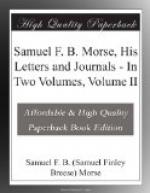“The machinery for the Telegraph goes forward daily; slowly but well and thorough. You will be surprised at the strength and quantity of machinery, greater, doubtless, than will eventually be necessary, yet it gives the main points, certainty and accuracy.”
It may be well to note here that Morse evidently foresaw that the machinery constructed by Alfred Vail was too heavy and cumbersome; that more delicate workmanship would later be called for, and this proved to be the case. The iron works at Morristown were only adapted to the manufacture of heavy machinery for ships, etc., and Alfred Vail had had experience in that class of work only, so that he naturally made the telegraphic instruments much heavier and more unwieldy than was necessary. While these answered the purpose for the time being, they were soon superseded by instruments of greater delicacy and infinitely smaller bulk made by more skilful hands.
The future looked bright to the sanguine inventor in the early days of the year 1838, as we learn from the following letter to his brother Sidney, written on the 13th of January:—
“Mr. Alfred Vail is just going in to New York and will return on Monday morning. The machinery is at length completed and we have shown it to the Morristown people with great eclat. It is the talk of all the people round, and the principal inhabitants of Newark made a special excursion on Friday to see it. The success is complete. We have tried the experiment of sending a pretty full letter, which I set up from the numbers given me, transmitting through two miles of wire and deciphered with but a single unimportant error.
“I am staying out to perfect a modification of my portrule and hope to see you on Tuesday, or, at the farthest, on Wednesday, when I shall tell you all about it. The matter looks well now, and I desire to feel grateful to Him who gives success, and be always prepared for any disappointment which He in infinite wisdom may have in store.”
We see from this letter, and from an account which appeared in the Morristown “Journal,” that in these exhibitions the messages were sent by numbers with the aid of the cumbersome dictionary which Morse had been at such pains to compile. Very soon after this, however, as will appear from what follows, the dictionary was discarded forever, and the Morse alphabet came into practical use.
The following invitation was sent from the New York University on January 22, 1838:—
“Professor Morse requests the honor of Thomas S. Cummings, Esq., and family’s company in the Geological Cabinet of the University, Washington Square, to witness the operation of the Electro-Magnetic Telegraph at a private exhibition of it to a few friends, previous to its leaving the city for Washington.
“The apparatus will be prepared at precisely twelve o’clock on Wednesday, 24th instant. The time being limited punctuality is specially requested.”




